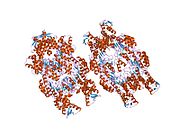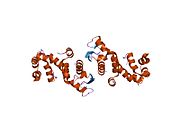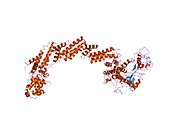User:JohnAngiostatic/sandbox
Structure and Function[edit]
Skp2 contains 424 residues in total with the ~40 amino acid F-box domain lying closer to the N-terminal region at the 94-140 position and the C-terminal region forming a concave surface consisting of ten leucine-rich repeats (LRRs).[1] The F-box proteins constitute one of the four subunits of ubiquitin protein ligase complex called SCFs (SKP1-cullin-F-box), which often—but not always—recognize substrates in a phosphorylation-dependent manner. In this SCF complex, Skp2 acts as the substrate recognition factor.[2][3][4] The F-box proteins are divided into three classes: Fbxws containing WD40 repeat domains, Fbxls containing leucine-rich repeats, and Fbxos containing either different protein–protein interaction modules or no recognizable motifs.[5] The protein encoded by this gene belongs to the Fbxls class; in addition to an F-box, this protein contains 10 tandem leucine-rich repeats. Alternative splicing of this gene generates 2 transcript variants encoding different isoforms. After the tenth LRR, the ~30-residue C-terminal tail turns back towards the first LRR, forming what has been referred to as a ‘safety-belt’ that might aid to pin down substrates into the concave surface formed by the LRRs.[6]
Skp2 forms a stable complex with the cyclin A-CDK2 S-phase kinase. It specifically recognizes and promotes the degradation of phosphorylated cyclin-dependent kinase inhibitor 1B (CDKN1B, also referred to as p27 or KIP1) predominantly in S, G2, and the initial part of the M phase.[7][8]
Role in Cell Cycle Regulation[edit]
Progression through the cell cycle is tightly regulated by cyclin-dependent kinases (CDKs), and their interactions with cyclins and CDK inhibitors (CKIs). Relative amounts of these signals oscillate during each stage of the cell cycle due to periodic proteolysis[9]; the ubiquitin-proteasome system mediates the degradation of these mitotic regulatory proteins, controlling their intracellular concentrations.[10][11] These and other proteins are recognized and degraded by the proteasome from the sequential action of three enzymes: E1 (ubiquitin-activating enzyme), one of many E2s (ubiquitin-conjugating enzymes), and one of many E3s (ubiquitin ligases).[12] The specificity of ubiquitination is provided by the E3 ligases; these ligases physically interact with the target substrates. Skp2 is the substrate recruiting component of the SCFSkp2 complex, which targets cell cycle control elements, such as p27 and p21.
Clinical Significance[edit]
One of the most critical CDK inhibitors involved in cancer pathogenesis is p27Kip1, which is involved primarily in inhibiting cyclin E-CDK2 complexes (and to a lesser extent cyclin D-CDK4 complexes).[13] Levels of p27Kip1 (like all other CKIs) rise and fall in cells as they either exit or re-enter the cell cycle, these levels are not modulated at the transcriptional level, but by the actions of the SCFSkp2 complex in recognizing p27Kip1 and tagging it for destruction in the proteasome system.[9] It has been shown that as cells enter G0 phase, reducing levels of Skp2 explain the increase in p27Kip1, creating an apparent inverse relationship between Skp2 and p27Kip1.[14] Robust evidence has been amassed that strongly suggests Skp2 plays an important role in cancer. Overexpression of Skp2 is frequently observed in human cancer progression and metastasis, and evidence suggests that Skp2 plays a proto-oncogenic role both in vitro and in vivo.[15] Skp2 overexpression has been seen in lymphomas[16], prostate cancer[17], melanoma[18], nasopharyngeal carcinoma[19][20], pancreatic cancer[21], and breast carcinomas.[22][23] Also, Skp2 overexpression promotes growth and tumorigenesis in a xenograft tumor model.[24] By extension of this fact, Skp2 inactivation profoundly restricts cancer development by triggering a massive cellular senescence and/or apoptosis response that is surprisingly observed only in oncogenic conditions in vivo.[25] This response is triggered in a p19Arf/p53-independent, but p27-dependent manner.[25] Using a Skp2 knockout mouse model, multiple groups have shown Skp2 is required for cancer development in different conditions of tumor promotion, including PTEN, ARF, pRB in activation as well as Her2/Neu overexpression.[20] Genetic approaches have demonstrated that Skp2 deficiency inhibits cancer development in multiple mouse models by inducing p53-indepedent cellular senescence and blocking Akt-mediated aerobic glycolysis.[26] Akt activation by Skp2 is linked to aerobic glycolysis, as Skp2 deficiency impairs Akt activation, Glut1 expression, and glucose uptake thereby promoting cancer development.
Potential Use as a Clinical Target[edit]
Skp2 is of considerable interest as a novel and attractive target for cancer therapeutical development, as disrupting the SCF complex will result in increased levels of p27, which will inhibit aberrant cellular proliferation. Although Skp2 is an enzyme, its function requires the assembly of the other members of the SCF complex. Effective inhibitors then must target the interfaces of the components of the SCF complex, which is much more difficult than traditional enzyme inhibition. Small molecule inhibitors of the binding site between Skp2 and the accessory protein Cks1 have been discovered, and these inhibitors induce p27 accumulation in a Skp2-dependent manner and promote cell cycle arrest.[20]
References[edit]
- ^ Bai C, Sen P, Hofmann K, Ma L, Goebl M, Harper JW, Elledge SJ (July 1996). "SKP1 connects cell cycle regulators to the ubiquitin proteolysis machinery through a novel motif, the F-box". Cell. 86 (2): 263–74. doi:10.1016/S0092-8674(00)80098-7. PMID 8706131.
{{cite journal}}: CS1 maint: date and year (link) CS1 maint: multiple names: authors list (link) - ^ Chan, CH.; Lee, SW.; Wang, J.; Lin, HK. (2010). "Regulation of Skp2 expression and activity and its role in cancer progression". ScientificWorldJournal. 10: 1001–15. doi:10.1100/tsw.2010.89. PMC 5763972. PMID 20526532.
{{cite journal}}: CS1 maint: unflagged free DOI (link) - ^ Zheng, N.; Schulman, BA.; Song, L.; Miller, JJ.; Jeffrey, PD.; Wang, P.; Chu, C.; Koepp, DM.; Elledge, SJ. (Apr 2002). "Structure of the Cul1-Rbx1-Skp1-F boxSkp2 SCF ubiquitin ligase complex". Nature. 416 (6882): 703–9. doi:10.1038/416703a. PMID 11961546.
{{cite journal}}: CS1 maint: date and year (link) - ^ Nakayama, KI.; Nakayama, K. (Jun 2005). "Regulation of the cell cycle by SCF-type ubiquitin ligases". Semin Cell Dev Biol. 16 (3): 323–33. doi:10.1016/j.semcdb.2005.02.010. PMID 15840441.
{{cite journal}}: CS1 maint: date and year (link) - ^ Kipreos ET, Pagano M (2000). "The F-box protein family". Genome Biol. 1 (5): REVIEWS3002. doi:10.1186/gb-2000-1-5-reviews3002. PMC 138887. PMID 11178263.
{{cite journal}}: CS1 maint: unflagged free DOI (link) - ^ Cardozo, T.; Pagano, M. (Sep 2004). "The SCF ubiquitin ligase: insights into a molecular machine". Nat Rev Mol Cell Biol. 5 (9): 739–51. doi:10.1038/nrm1471. PMID 15340381.
{{cite journal}}: CS1 maint: date and year (link) - ^ Carrano AC, Eytan E, Hershko A, Pagano M (August 1999). "SKP2 is required for ubiquitin-mediated degradation of the CDK inhibitor p27". Nat. Cell Biol. 1 (4): 193–9. doi:10.1038/12013. PMID 10559916.
{{cite journal}}: CS1 maint: date and year (link) CS1 maint: multiple names: authors list (link) - ^ Tsvetkov LM, Yeh KH, Lee SJ, Sun H, Zhang H (June 1999). "p27(Kip1) ubiquitination and degradation is regulated by the SCF(Skp2) complex through phosphorylated Thr187 in p27". Curr. Biol. 9 (12): 661–4. doi:10.1016/S0960-9822(99)80290-5. PMID 10375532.
{{cite journal}}: CS1 maint: date and year (link) CS1 maint: multiple names: authors list (link) - ^ a b Murray, AW. (Jan 2004). "Recycling the cell cycle: cyclins revisited". Cell. 116 (2): 221–34. doi:10.1016/s0092-8674(03)01080-8. PMID 14744433.
{{cite journal}}: CS1 maint: date and year (link) - ^ Weissman, AM. (Mar 2001). "Themes and variations on ubiquitylation". Nat Rev Mol Cell Biol. 2 (3): 169–78. doi:10.1038/35056563. PMID 11265246.
{{cite journal}}: CS1 maint: date and year (link) - ^ Pickart, CM. (Jan 2004). "Back to the future with ubiquitin". Cell. 116 (2): 181–90. doi:10.1016/s0092-8674(03)01074-2. PMID 14744430.
{{cite journal}}: CS1 maint: date and year (link) - ^ Frescas, D.; Pagano, M. (Jun 2008). "Deregulated proteolysis by the F-box proteins SKP2 and beta-TrCP: tipping the scales of cancer". Nat Rev Cancer. 8 (6): 438–49. doi:10.1038/nrc2396. PMC 2711846. PMID 18500245.
{{cite journal}}: CS1 maint: date and year (link) - ^ Viglietto, G.; Motti, ML.; Bruni, P.; Melillo, RM.; D'Alessio, A.; Califano, D.; Vinci, F.; Chiappetta, G.; Tsichlis, P. (Oct 2002). "Cytoplasmic relocalization and inhibition of the cyclin-dependent kinase inhibitor p27(Kip1) by PKB/Akt-mediated phosphorylation in breast cancer". Nat Med. 8 (10): 1136–44. doi:10.1038/nm762. PMID 12244303.
{{cite journal}}: CS1 maint: date and year (link) - ^ Bashir, T.; Dorrello, NV.; Amador, V.; Guardavaccaro, D.; Pagano, M. (Mar 2004). "Control of the SCF(Skp2-Cks1) ubiquitin ligase by the APC/C(Cdh1) ubiquitin ligase". Nature. 428 (6979): 190–3. doi:10.1038/nature02330. PMID 15014502.
{{cite journal}}: CS1 maint: date and year (link) - ^ Chan, CH.; Lee, SW.; Wang, J.; Lin, HK. (2010). "Regulation of Skp2 expression and activity and its role in cancer progression". ScientificWorldJournal. 10: 1001–15. doi:10.1100/tsw.2010.89. PMC 5763972. PMID 20526532.
{{cite journal}}: CS1 maint: unflagged free DOI (link) - ^ Seki, R.; Okamura, T.; Koga, H.; Yakushiji, K.; Hashiguchi, M.; Yoshimoto, K.; Ogata, H.; Imamura, R.; Nakashima, Y. (Aug 2003). "Prognostic significance of the F-box protein Skp2 expression in diffuse large B-cell lymphoma". Am J Hematol. 73 (4): 230–5. doi:10.1002/ajh.10379. PMID 12879424.
{{cite journal}}: CS1 maint: date and year (link) - ^ Wang, Z.; Gao, D.; Fukushima, H.; Inuzuka, H.; Liu, P.; Wan, L.; Sarkar, FH.; Wei, W. (Jan 2012). "Skp2: a novel potential therapeutic target for prostate cancer". Biochim Biophys Acta. 1825 (1): 11–7. doi:10.1016/j.bbcan.2011.09.002. PMC 3242930. PMID 21963805.
{{cite journal}}: CS1 maint: date and year (link) - ^ Rose, AE.; Wang, G.; Hanniford, D.; Monni, S.; Tu, T.; Shapiro, RL.; Berman, RS.; Pavlick, AC.; Pagano, M. (Feb 2011). "Clinical relevance of SKP2 alterations in metastatic melanoma". Pigment Cell Melanoma Res. 24 (1): 197–206. doi:10.1111/j.1755-148X.2010.00784.x. PMC 3341662. PMID 20883453.
{{cite journal}}: CS1 maint: date and year (link) - ^ Fang, FM.; Chien, CY.; Li, CF.; Shiu, WY.; Chen, CH.; Huang, HY. (Jan 2009). "Effect of S-phase kinase-associated protein 2 expression on distant metastasis and survival in nasopharyngeal carcinoma patients". Int J Radiat Oncol Biol Phys. 73 (1): 202–7. doi:10.1016/j.ijrobp.2008.04.008. PMID 18538504.
{{cite journal}}: CS1 maint: date and year (link) - ^ a b c Xu, HM.; Liang, Y.; Chen, Q.; Wu, QN.; Guo, YM.; Shen, GP.; Zhang, RH.; He, ZW.; Zeng, YX. (Mar 2011). "Correlation of Skp2 overexpression to prognosis of patients with nasopharyngeal carcinoma from South China". Chin J Cancer. 30 (3): 204–12. doi:10.5732/cjc.010.10403. PMC 4013317. PMID 21352698.
{{cite journal}}: CS1 maint: date and year (link) Cite error: The named reference "”" was defined multiple times with different content (see the help page). - ^ Schüler, S.; Diersch, S.; Hamacher, R.; Schmid, RM.; Saur, D.; Schneider, G. (Jan 2011). "SKP2 confers resistance of pancreatic cancer cells towards TRAIL-induced apoptosis". Int J Oncol. 38 (1): 219–25. PMID 21109943.
{{cite journal}}: CS1 maint: date and year (link) - ^ Radke, S.; Pirkmaier, A.; Germain, D. (May 2005). "Differential expression of the F-box proteins Skp2 and Skp2B in breast cancer". Oncogene. 24 (21): 3448–58. doi:10.1038/sj.onc.1208328. PMID 15782142.
{{cite journal}}: CS1 maint: date and year (link) - ^ Zheng, WQ.; Zheng, JM.; Ma, R.; Meng, FF.; Ni, CR. (Oct 2005). "Relationship between levels of Skp2 and P27 in breast carcinomas and possible role of Skp2 as targeted therapy". Steroids. 70 (11): 770–4. doi:10.1016/j.steroids.2005.04.012. PMID 16024059.
{{cite journal}}: CS1 maint: date and year (link) - ^ Lin, HK.; Wang, G.; Chen, Z.; Teruya-Feldstein, J.; Liu, Y.; Chan, CH.; Yang, WL.; Erdjument-Bromage, H.; Nakayama, KI. (Apr 2009). "Phosphorylation-dependent regulation of cytosolic localization and oncogenic function of Skp2 by Akt/PKB". Nat Cell Biol. 11 (4): 420–32. doi:10.1038/ncb1849. PMC 2830812. PMID 19270694.
{{cite journal}}: CS1 maint: date and year (link) - ^ a b Lin, HK.; Chen, Z.; Wang, G.; Nardella, C.; Lee, SW.; Chan, CH.; Chan, CH.; Yang, WL.; Wang, J. (Mar 2010). "Skp2 targeting suppresses tumorigenesis by Arf-p53-independent cellular senescence". Nature. 464 (7287): 374–9. doi:10.1038/nature08815. PMC 2928066. PMID 20237562.
{{cite journal}}: CS1 maint: date and year (link) - ^ Chan, CH.; Li, CF.; Yang, WL.; Gao, Y.; Lee, SW.; Feng, Z.; Huang, HY.; Tsai, KK.; Flores, LG. (May 2012). "The Skp2-SCF E3 ligase regulates Akt ubiquitination, glycolysis, herceptin sensitivity, and tumorigenesis". Cell. 149 (5): 1098–111. doi:10.1016/j.cell.2012.02.065. PMC 3586339. PMID 22632973.
{{cite journal}}: CS1 maint: date and year (link)





